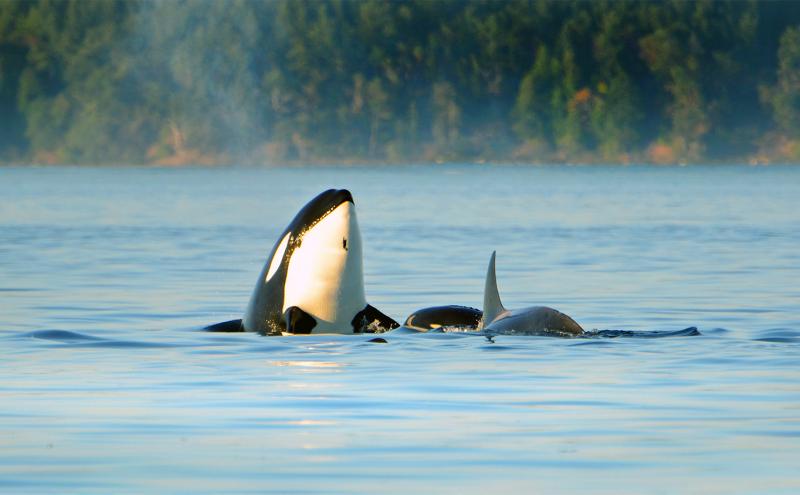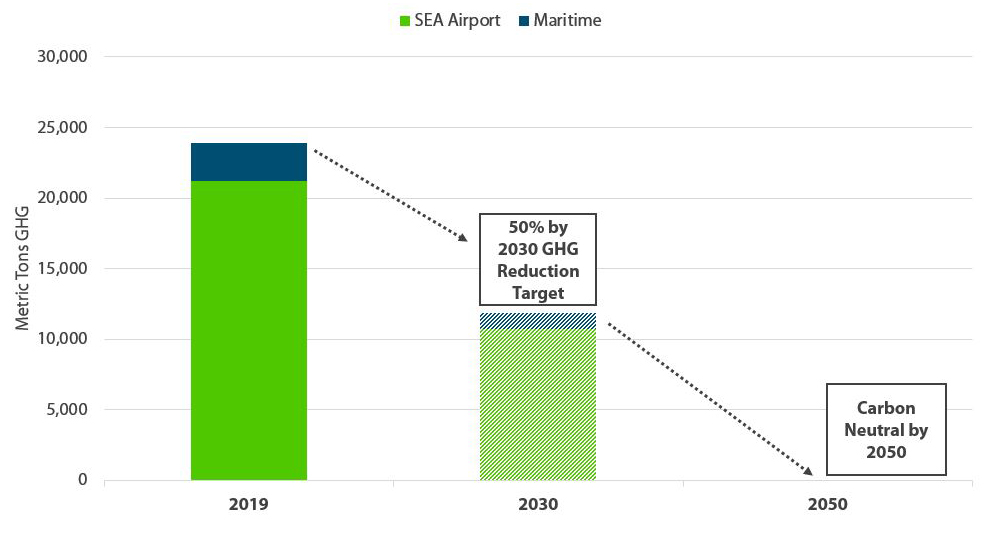
The Port of Seattle marks the 51st Earth Day this month with a focus on industry, policy, and community actions to reduce pollution, phase out emissions, and create an equitable green economy.
“Climate change is an urgent global problem with local consequences” said Port of Seattle Commissioner Peter Steinbrueck, co-chair of the Port’s Energy and Sustainability Committee. “We must do more and more quickly. The Port is making major investments to improve air and water quality, and we’re committed to fully de-carbonizing the waterfront through shore power at all major cruise and container berths by 2030.”
Commissioner Stephanie Bowman elaborated, “We know that to address the climate crisis we must address social inequity. That’s why the Port is investing in green-collar jobs and community-led green economy projects. We’ve also made a commitment that the benefits of a green economy go to underserved communities first.”
Increasing transparency with a new annual emissions inventory
The Port of Seattle is deeply committed to be a highly effective public agency, which is intertwined with the organization’s core values such as accountability, open communication, responsible stewardship, and transparency. Publishing the Port’s Greenhouse Gas Emissions Inventory is an ongoing public, data-driven resource that increases transparency and accessibility to illustrate how the Port is performing on its air and climate strategies.
2019 Port-wide Scope 1 and 2 Greenhouse Gas Emissions by Operation

Earlier this month, the Port joined with the Port of Tacoma, Northwest Seaport Alliance, and Vancouver Fraser Port Authority (British Columbia) to announce the Northwest Ports Clean Air Strategy, an ambitious shared vision to phase out all emissions from seaport-related activities by 2050.
The Port is seeking input from near-port community on near-term emission reduction actions, such as installing shore power for cruise ships, transitioning to an all-electric fleet, and eliminating the use of fossil natural gas in Port buildings.
The Port’s emission reduction strategy depends upon the availability and affordability of cleaner fuels, a key advocacy priority for the Port at the state, federal, and international level.
Scope 1 and 2 GHG Emissions
The Port conducts two separate GHG emissions inventories: one for GHG emissions associated with Seattle-Tacoma International Airport (SEA); and another for GHG emissions from Maritime such as fleets and buildings and facilities along the Seattle waterfront. Both inventories together document the Port’s total contribution to GHG emissions.
In many cases, Port facilities and operations successfully reduced emissions by transitioning to cleaner fuels, like renewable diesel and renewable natural gas, installing energy efficient equipment and lighting, and piloting solar power.
In October of 2020, SEA Airport became the first airport in the country to purchase renewable natural gas derived from waste. This decision to use RNG to heat SEA Airport and power the airport's bus fleet will significantly reduce the Port's Scope 1 and 2 GHG emissions, allowing the Port to meet its 2030 goal 10 years early. The impact of RNG on the Port's GHG emissions will be represented in the 2020 inventory results and will be available later this year.
Scope 3 GHG Emissions
The Port also tracks Scope 3 greenhouse gas emissions that are a consequence of the Port's activity but are owned or controlled by other entities.
For example, Scope 3 emissions sources encompass energy used by Port tenants, airplanes, ground transportation to and from the airport, cruise ships and other ocean-going vessels, cargo-handling equipment, rail locomotives, waste transport and disposal, employee business travel by air, and even Port employees commuting to and from work.
Scope 3 emissions are the most difficult to reduce and the most significant in terms of impact. To address these emissions the Port needs both legislation and industry collaboration. Collaboration through the Northwest Ports Clean Air Strategy and early actions underway like planning for clean energy along the Seattle waterfront are critical efforts to address Scope 3 emissions from maritime sources.
The Port’s inventory shows that Scope 3 maritime emissions declined 20 percent over 2005 levels. The airport’s Scope 3 greenhouse gas emissions inventory is anticipated to show growth in emissions associated with increased aircraft operations since 2005.
A detailed comparison of the 2006 vs. 2016 Scope 3 emissions for SEA will publish on the Port’s website in June 2021.
On Tuesday, April 27 the Port Commission will convene a study session of Port environmental experts, local aviation and business leaders for an update on the strategy to deploy Sustainable Aviation Fuel at SEA Airport.
Partnering with community
The Port of Seattle has a long-term goal to be the greenest and most energy-efficient port in North America. The Port’s commitment to leading an equitable recovery includes a focus on how environmental structures and practices influence disparity within our communities.
On April 13th, Commissioners received an update on a $450,000 grant to non-profit Forterra to implement Green City Partnership (GCP) program to support long-term forest stewardship in SeaTac, Burien, and Des Moines. Under the program Forterra collected feedback from 300 community members and worked with all three cities on Urban Forest Enhancement Plans that include a Tree Canopy Cover Assessment, a Forest Health Assessment, and findings from extensive community engagement activities (see Burien guide, Des Moines guide, SeaTac guide)
In this final year of implementation, the Port and Forterra are piloting a green jobs pathway program. This is a first for the entire network of 15 Green Cities and Counties. Investments from the Port’s Opportunity Motion and South King County Fund supported paid positions for immigrant youth through Partner in Employment (PIE). Additionally, Forterra will focus on supporting city parks staff to implement on-the-ground improvements including volunteer recruitment and management, tree planting, invasive species removal, and maintenance of restoration areas.
The partnership with Forterra began through the Port’s Airport Communities Ecology Fund, which recognizes that neighboring communities that experience more impacts from airport operations should also experience more benefits. The Commission directed that the program support environmental projects and programs in the cities of SeaTac, Burien, and Des Moines.
The success of the ACE Fund inspired the Port to create the South King County Fund (SKCF) to develop equity-based partnerships and provide resources and support in historically underserved near-airport communities. The fund will award $10 million between 2019 and 2023 to address airport noise, environmental health, and sustainability in these ethnically and culturally diverse communities. In February 2021 the Port announced the fourteen organizations to receive the first environmental grants under the South King County Fund.
“This grant means a lot to not only our community but also for the broader community,” said Kamal Adhikari of the Bhutanese Community Resource Center, one of the South King County Fund environmental grant recipients. “We will be working on creating green canopy and a safe and clean park to play. It will be a beautiful place for our generation to come. Community can thrive only if there is clean water to drink, healthy food to eat, safe and clean park to play, and fresh air to breathe.”
On the seaport side, In December 2019 the Port of Seattle Commission approved its long-term commitment to equity and outreach efforts in the Duwamish Valley through an adoption of the Duwamish Valley Community Benefits Commitment. Resolution 3767, the first of its kind at the Port of Seattle, harnesses the Port’s economic development mission to promote community partnerships, healthy environments and communities, and economic prosperity. The new policy makes permanent a pilot program from earlier this year.
Since then the partnership has led to recruitment events for Port-related careers, new green jobs programs and paid opportunities for nearly 50 youth, community engagement campaign to rename six Port-owned parks along the Duwamish River, in partnership with Seattle Parks Foundation and Duwamish Valley community leaders in 2020, workshops on equitable development, community benefits agreements, environmental justice, and collaborative problem-solving, and funding for community science research to identify air quality solutions in Georgetown and South Park. Much more about the Duwamish Valley Community Benefits Commitment is on the Port’s webpage.
Subscribe for environmental updates!
The Port will launch its first ever environmental email newsletter, The Evergreen, at the end of April as a grand finale to Earth Month. The Evergreen will keep community and environmental stakeholders informed of the Port’s sustainability program as well as projects and opportunities to partner on our work. Subscribe to The Evergreen, or manage your subscriptions to other Port email updates.
Contact
Peter McGraw | Port of Seattle Media Officer
(206) 787-3446 | [email protected]

